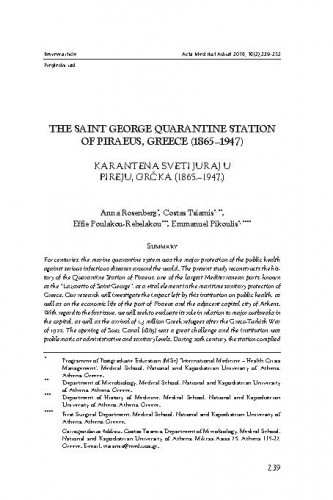For centuries, the marine quarantine system was the major protection of the public health against serious infectious diseases around the world. The present study reconstructs the history of the Quarantine Station of Piraeus, one of the largest Mediterranean ports, known as the “Lazaretto of Saint George”, as a vital element in the maritime sanitary protection of Greece. Our research will investigate the impact left by this institution on public health, as well as on the economic life of the port of Piraeus and the adjacent capital city of Athens. With regard to the first issue, we will seek to evaluate its role in relation to major outbreaks in the capital, as well as the arrival of 1.3 million Greek refugees after the Greco-Turkish War of 1922. The opening of Suez Canal (1865) was a great challenge and the institution was problematic at administrative and sanitary levels. During 20th century, the station complied with the national public health legislation and the international sanitary conventions. Until the Second World War, the Lazaretto of Saint George played a key role in both the protection of public health in general, but also in the economic and industrial progress of Piraeus and Athens.; Stoljećima je morski karantenski sustav bio glavna zaštita javnog zdravlja od ozbiljnih zaraznih bolesti širom svijeta. Ovo istraživanje rekonstruira povijest karantene u Pireju, jednoj od najvećih mediteranskih luka, poznatoj pod nazivom Lazaret svetog Jurja, kao bitnog elementa pomorske sanitarne zaštite Grčke. Naše istraživanje proučit će utjecaj ove institucije na javno zdravstvo te gospodarski život luke Pirej i susjednoga glavnog grada Atene. Uz to, nastojat ćemo procijeniti ulogu lazareta u odnosu na velike epidemije u glavnom gradu i njegovu ulogu pri dolasku 1,3 milijuna grčkih izbjeglica nakon Grčko-turskog rata 1922. Otvaranje Sueskog kanala (1865.) značilo je velik izazov, a djelovanje institucije bilo je problematično na administrativnoj i sanitarnoj razini. Tijekom 20. stoljeća ustanova se uskladila s nacionalnim javnozdsaint ravstvenim zakonodavstvom i međunarodnim sanitarnim konvencijama. Do Drugoga svjetskog rata Lazaret sv. Jurja imao je važnu ulogu u zaštiti javnog zdravstva općenito, kao i u gospodarskom i industrijskom razvoju Pireja i Atene.
Sažetak

 Acta medico-historica Adriatica : 16,2(2018) / glavni urednik, editor-in-chief Igor Eterović.
Acta medico-historica Adriatica : 16,2(2018) / glavni urednik, editor-in-chief Igor Eterović.